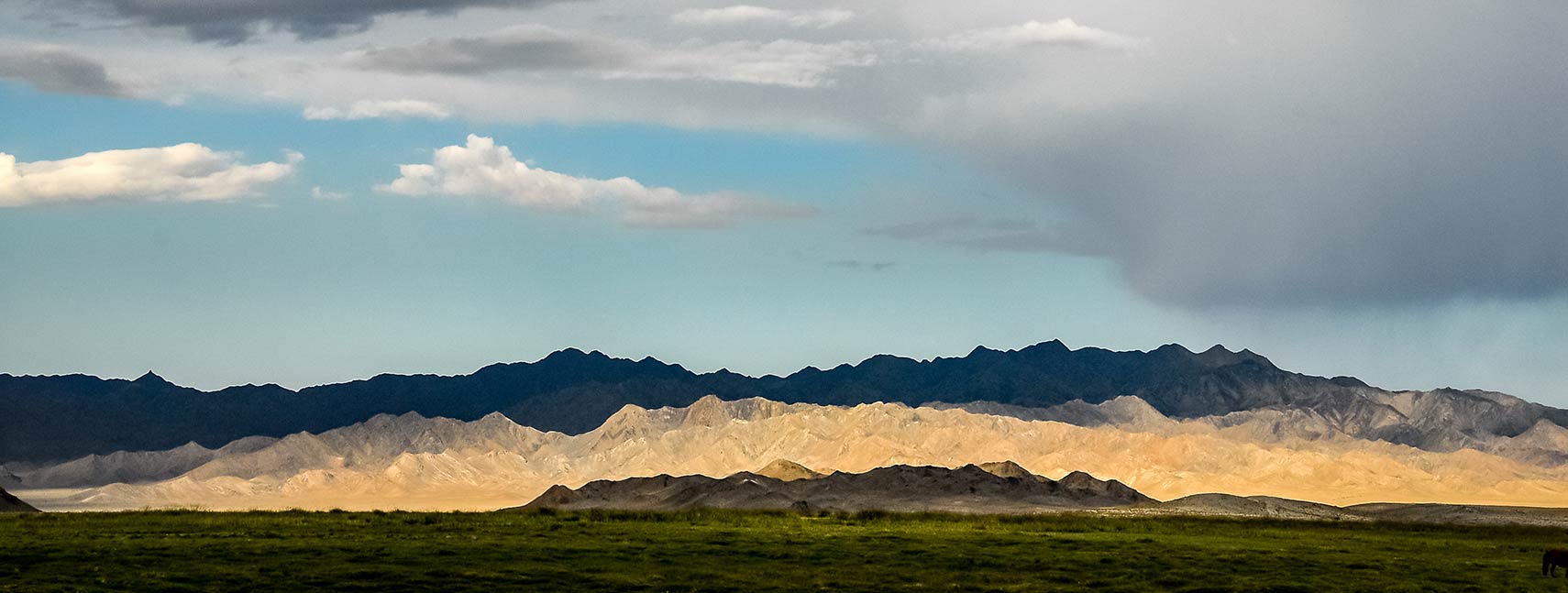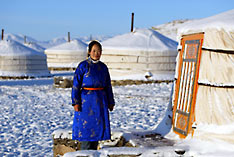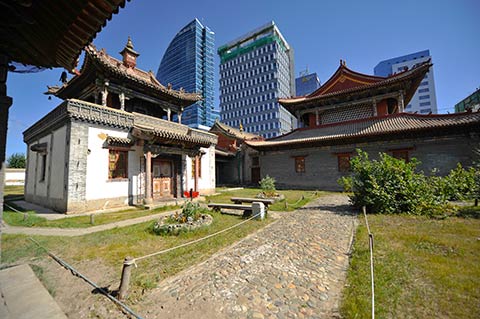| Home |
___ Mongolia |
 Mongolian Landscape with Clouds in Khovd Province, Mongolia. Image: Bernd Thaller |
The area of what is now Mongolia has been ruled by various nomadic empires for centuries. In 1206, Genghis Khan founded the Mongol Empire, and his grandson Kublai Khan conquered China to establish the Yuan dynasty. The roughly oval in shaped country covers an area of 1,564,100 km², compared Mongolia is twice the size of Turkey or slightly smaller than Alaska. Mongolia has a population of just over 3 million people (2016), making it one of the least densely populated countries in the world. 95% of the population are ethnic Mongols, Kazakh, Turkic peoples, Chinese and Russians make up the remaining population. Capital and and largest city is Ulaanbaatar (pop.: 1 million). Official language is Mongolian, a language written in Cyrillic and in the traditional Mongolian script. |
|
|
Mongolia | Mongol Uls |
Country Profile |
Background: Long a province of China, Mongolia won its independence in 1921 with Soviet backing. A communist regime was installed in 1924. During the early 1990s, the ex-communist Mongolian People's Revolutionary Party (MPRP) gradually yielded its monopoly on power. In 1996, the Democratic Union Coalition (DUC) defeated the MPRP in a national election. Over the next four years the Coalition implemented a number of key reforms to modernize the economy and institutionalize democratic reforms. However, the former communists were a strong opposition that stalled additional reforms and made implementation difficult. In 2000, the MPRP won 72 of the 76 seats in Parliament and completely reshuffled the government. While it continues many of the reform policies, the MPRP is focusing on social welfare and public order priorities. (Source: CIA - The World Factbook) border countries: China, Russia |
Official Name: Mongol Uls int'l form: Mongolia former: Outer Mongolia ISO Country Code: mn Time: Local Time = UTC +8h Actual Time: Tue-Apr-23 22:21 DST March - September (UTC +9h). Country Calling Code: +976 Capital City: Ulaanbaatar, (Ulan Bator) founded in 1639 (pop. 1 million) Other Cities: Darkhan (95 000 inhabitants) and Erdenet (74 000 inhabitants) Government: Type: Parliamentary Republic. Independence: gained in 1921; in 1990, democratic reform begun and shift from dependence on the former Soviet Union declared. Constitutions: 1960 and 12 February 1992. Geography: Location: Northern Asia, between China and Russia. Area: 1,564,100 km² (603,863 sq. mi.); Terrain: vast semidesert and desert plains, grassy steppe, mountains in west and southwest; Gobi Desert in south-central; almost 90% of land area is pasture or desert, of varying usefulness; 1% arable; 9% forested. Climate: Sharp continental, marked by four seasons. Average summer temperature +17'C, average winter temperature -26'C. People: Nationality: Mongolian(s). Population: 3 million (2016) Ethnic groups: 85% Mongol (predominantly Khalkha), 7% Turkic (largest group, Kazakh) 4.6% Tungusic, and 3.4% others, including Chinese and Russian. Languages: Mongolian, Kazakh, Russian, and English. Religions: Tibetan Buddhist Lamaism 94%, Muslim 6% (primarily in the southwest), and Shamanism. Literacy: 90%. Natural resources: Oil, coal, copper, molybdenum, tungsten, phosphates, tin, nickel, zinc, fluorspar, gold, silver, iron. Agriculture products: Wheat, barley, vegetables, forage crops, sheep, goats, cattle, camels, horses. Industries: Construction and construction materials; mining (coal, copper, molybdenum, fluorspar, and gold); oil; food and beverages; processing of animal products, cashmere and natural fiber manufacturing. Exports - commodities: copper, apparel, livestock, animal products, cashmere, wool, hides, fluorspar, other nonferrous metals, coal, crude oil Exports - partners: China 84%, Switzerland 9% (2015) Imports - commodities: machinery and equipment, fuel, cars, food products, industrial consumer goods, chemicals, building materials, cigarettes and tobacco, appliances, soap and detergent Imports - partners: China 39.9%, Russia 28.4%, Japan 6.4%, South Korea 6.2% (2015) Currency: Togrog/Tugrik (MNT) Mongolia key statistical data. |
 South Side of the Government Palace in Ulaanbaatar on Chinggis Square. The palace houses the parliament of Mongolia (State Great Khural) and offices of the President and the Prime Minister. Image: Marco Fieber Political system Mongolia shed its one-party system in 1990. Today the country is a semi-presidential representative democratic republic with a multi-party system. Executive power is exercised by the President and the Government. Chief of state is the president, he has mostly a ceremonial role. Head of the government is the prime minister, elected by the parliament (State Great Khural). Official Sites of MongoliaNote: External links will open in a new browser window.Mongolia The Government of Mongolia Home Page. Mongolia Presidency Official site of the president of Mongolia. Mongolia Parliament Official site of the State Great Hural (Parliament) of Mongolia. Government Organizations of Mongolia Index of Governments Organizations. Ministry of Foreign Affairs of Mongolia Official site of the Ministry. Diplomatic Missions Permanent Mission of Mongolia to the United Nations Mongolia's representation to the UN. Embassy of Mongolia in the U.S. The Embassy at Washington, D.C. Diplomatic Missions Address list of Missions of Mongolia abroad and Foreign Missions to Mongolia. Statistics National Statistics Office Mongolia in figures. MapsPolitical map of Mongolia. Searchable map and satellite view of Mongolia. Searchable map and satellite view of Mongolia's capital city. Map of East Asia Political map of East Asia. Political map of Asia. |
NewsMontsame Mongolia's National News Agency. UB POST Mongolian independent English weekly newspaper. |
Bookmark/share this page 
|
 Shaman awas (ovoo), grouped at the outskirts of Ulaanbaatar. This is a gathering place for traditional rites and ceremonies of an ancient way of life. Image: carfull...home Arts & CultureArt Council of Mongolia Advocates and supports the sustainable development of Mongolian arts and culture. Culture Center of the Northern Asian First Peoples' Art For foreigner's & our first people's information, founded '96 in Ulan -Ude (Buryatia, Russia). Khoomii Throat singing is Mongolia's invaluable contribution to world. Mongol Art Designed to promote global interest and understanding of Mongolian arts and culture. Mongolia: The Legacy of Chinggis Khan Site of the presentation of Mongolian art at Asian Art Museum San Francisco. Mongolian Traditional Archery Information about the art of the bow. National Costumes of the Mongolian People's Republic History and tradition of Mongolian Costumes. The Realm of The Mongols Dedicated to the philosophical and spiritual legacy of the Old Mongols, and to the memory of Chingis Khan. |
 Little Mongol Warrior © mongoliatourism.gov.mn |
Business & EconomyMongolia's economy has traditionally been based on agriculture and livestock. The country has rich mineral deposits of gold, coal, copper, molybdenum, fluorspar, uranium, tin and tungsten. Mining is important to the national economy of Mongolia.Bank of Mongolia Central Bank of Mongolia. Mongolian Stock Exchange Mongolia's sole stock exchange is located in Ulaanbaatar. Mongolian National Chamber of Commerce and Industry Trade Promotion Organization in Mongolia (Member Organizations), founded in 1960. Invest Mongolia Agency Government agency to promote investment in Mongolia. Products of Mongolia Petroleum Authority of Mongolia Governmental organization responsible for the exploration, protection, production, processing, transportation, storage and marketing of petroleum in Mongolia. Ulaanbaatar carpet Hand- and machine -made Mongolian carpets. ___Transportation Airline MIAT Mongolian Airlines Serves destinations in Germany, Russia, and south east Asia. Rail Mongolian Railway Official site. Trans-Mongolian Railway Trans-Mongolian Route Description. |
 Ulaanabaatar © mongoliatourism.gov.mn |
 Rainbow in Mongolia during Naadam Festival in Mongolia's Khovd Province. Image: Bernd Thaller Travel and Tour Consumer Information
Destination Mongolia - Travel and Tour GuidesDiscover Mongolia: Ulaanbaatar (capital city, ), Mongol Altai (mountains) Gobi Desert (desert), Gobi Gurvansaikhan National Park (Gobi three beauties nature complex); Khongoryn Els (Singing Sands, 1000 km² of sand dunes); Nayramadlin Orgil (Khüiten Peak at Tavan Bogd, highest mountain in the country at 4,374 m); Lake Khövsgöl (largest fresh water lake in Mongolia), Karakorum (13th century capital of Chingis Khan, monastery, part of the Orkhon Valley Cultural Landscape); Naadam Festival (Mongol style fun: wrestling, horse racing, archery), Find accommodation, hotels, adventure travel, attractions, festivals, events, tourist boards, tours and much more. Mongolia - Nomadic by Nature Official tourism information about Mongolia by the Ministry of Environment, Green Development and Tourism. Mongolia photo Photo gallery with high quality pictures of Mongolia. Mongoluls.net A Mongolia portal provides information on Mongolian traditions and culture, geography and much more. Virtual Mongolia Mongolia Traveler Magazine. Visit Mongolia A travel and tourism guide to Mongolia. City-Guide Ulaanbaatour Official tourism website of Mongolia's capital city. Tour Operators Black Ibex Expeditions A specialist tour operator located in Ulaanbaatar. Discover Mongolia Mongolia Guide including a Photo Gallery. Gobi Expeditions Mongolia Adventure Travel company based in Ulaanbaatar offers a wide range of activities throughout the country. Mongolian Adventure Tours All-inclusive and mini-package tour services. Visit Mongolia Tourist company with information on Mongolia. 20 facts about Mongolia - by Discover Mongolia Travel |
 Yurt (ger) with the Gurvan Saikhan Mountains in background. Image: Adagio  Gers are the traditional tents of the nomads. © mongoliatourism.gov.mn  Nomad family © mongoliatourism.gov.mn  Choijin Lama Temple Museum in Ulaanbaatar. Image: Zazaa Mongolia |
EducationNational University of Mongolia (NUM) NUM is the country's oldest and only comprehensive university and a leading center of sciences, education and culture, stablished on 5 October 1942. |
 Khongoryn Els sand dunes also known as 'singing sands' in the Gobi Gurvansaikhan National Park. Image: Sarah Lachise Environment & NatureMongolian Biodiversity & Ecological Studies The mission of the Institute for Mongolian Biodiversity and Ecological Studies is to stimulate and help coordinate biodiversity and ecological research in Mongolia. Mongolian Nature and Environment Consortium An alliance of 14 nature and environment conservation research institutes, centers and NGOs of Mongolia. |
 Stupas around Erdene Zuu monastery in Karakorum. Image: Aloxe HistoryBrief History of Mongolia Mongolia's history from the ancient periods unil today. History of Mongolia Information on various periods of Mongolia's History. History of Buryatia (Ar Mongol) Buryat Mongols are significant minorities in Mongolia and Inner Mongolia. Historical Path of Mongolia's Statehood and Independence Mongolian history of the 20th century. The Mongol Empire More about the largest empire in human history. The Mongol Khâns History of Mongolia and the Khans. Mongols Wikipedia entry about the the Mongols and the Mongol Empire. Timeline of Chinese Imperial and Modern Dynasties. |
Sources and additional Information on MongoliaAmnesty International: Mongolia BBC Country Profile: Mongolia The Center for the Study of Eurasian Nomads (CSEN) Nomadic cultures who lived in, or are currently living in Eurasia. Eurasianet: Mongolia FAO: Mongolia GlobalEDGE: Mongolia The Heritage Foundation: Mongolia Human Rights Watch: Mongolia Infosystem Mongolia An Internet-based Journal on Mongolian Affairs, stablished in November 1993 as the first information base on Mongolia in the Internet. OEC: Mongolia Reporters Without Borders: Mongolia The United Nations in Mongolia Wikipedia: Mongolia The World Factbook -- Mongolia |
 |
Other Countries in East Asia: China (PRC) | Japan | North Korea | South Korea | Taiwan (ROC) Special Administrative Regions of China: Hong Kong | Macau | Tibet Major cities in Eastern Asia: Beijing, Busan, Chongqing, Fukuoka, Guangzhou, Hanoi, Ho Chi Minh City, Hong Kong, Kobe, Kunming, Kyoto, Lhasa, Macao, Nagoya, Osaka, Pyongyang, Sapporo, Seoul, Shanghai, Shenzhen, Taipei, Tianjin, Tokyo, Ulaanbaatar, Yokohama |
One World - Nations Online .:. let's care for this planet Promote that every nation assumes responsibility for our world. Nations Online Project is made to improve cross-cultural understanding and global awareness. More signal - less NOISE |
| Site Map
| Information Sources | Disclaimer | Copyright © 1998-2023 :: nationsonline.org |